Michael Offutt's Blog, page 137
April 23, 2013
Undead are rare in the Clone Wars but they do exist and so does magic
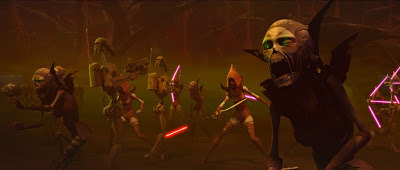 Undead Dathomirian Nightsisters. Kinda cool eh? Click to Embiggen.I think that most people tend to think of Star Wars as lying firmly in the genre of science fiction space opera. However, I tend to think of it as a fantasy more than science-fiction. The Jedis are just wizards with swords, and then there's the whole Nightsister clan that gave birth to Asajj Ventress (Sith apprentice to Count Dooku depending on where you find her in the storyline) on the planet Dathomir.
Undead Dathomirian Nightsisters. Kinda cool eh? Click to Embiggen.I think that most people tend to think of Star Wars as lying firmly in the genre of science fiction space opera. However, I tend to think of it as a fantasy more than science-fiction. The Jedis are just wizards with swords, and then there's the whole Nightsister clan that gave birth to Asajj Ventress (Sith apprentice to Count Dooku depending on where you find her in the storyline) on the planet Dathomir.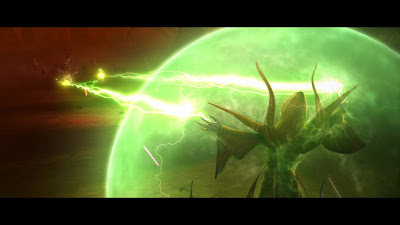 Mother Talzin is a bonafide true sorceress in the complete sense of the word.The episode "Massacre" is number 19 in season four. After failing to kill Dooku or control Savage Opress, Asajj Ventress is advised by Mother Talzin to reject the ways of the Sith and rejoin the Nightsisters. However, an angered and fearful Count Dooku is determined to see the end of Ventress and Mother Talzin. Via Dooku's command, General Grievous launches a droid assault, only to find an army of undead Dathomirian Nightsisters' awakened by Daka, the eldest of the Sister's clan. Talzin creates a voodoo doll to finish off Dooku, whilst Ventress and Grievous square-off in saber combat. Ventress downs Grievous, however she is helpless to watch as the last of her sisters on Dathomir are massacred. The episode closes with the green misty spirit of Mother Talzin bidding farewell and good luck to Ventress, whom is now left to grieve for her clan.
Mother Talzin is a bonafide true sorceress in the complete sense of the word.The episode "Massacre" is number 19 in season four. After failing to kill Dooku or control Savage Opress, Asajj Ventress is advised by Mother Talzin to reject the ways of the Sith and rejoin the Nightsisters. However, an angered and fearful Count Dooku is determined to see the end of Ventress and Mother Talzin. Via Dooku's command, General Grievous launches a droid assault, only to find an army of undead Dathomirian Nightsisters' awakened by Daka, the eldest of the Sister's clan. Talzin creates a voodoo doll to finish off Dooku, whilst Ventress and Grievous square-off in saber combat. Ventress downs Grievous, however she is helpless to watch as the last of her sisters on Dathomir are massacred. The episode closes with the green misty spirit of Mother Talzin bidding farewell and good luck to Ventress, whom is now left to grieve for her clan.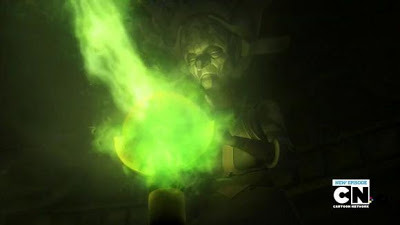 This is Daka, Eldest of the Nightsister clan. Unlike other grandmothers
This is Daka, Eldest of the Nightsister clan. Unlike other grandmotherswho bake bread, Daka is a super powerful necromancer who calls forth
undead from their graves to defend their homeworld. I guess she also makes
a mean stew.
 My take: I love the special effects in this episode and the Nightsisters made for some very interesting characters. It kind of added a third element to Star Wars. On the one side we have the Jedi. On the other we have the Sith. And then there's this murky gray area of practicing witches that can cast actual magic. Mother Talzin demonstrated tremendous power. She had illusions, could create objects out of nothing, turn her people invisible or into undead warriors, and the list goes on and on.
My take: I love the special effects in this episode and the Nightsisters made for some very interesting characters. It kind of added a third element to Star Wars. On the one side we have the Jedi. On the other we have the Sith. And then there's this murky gray area of practicing witches that can cast actual magic. Mother Talzin demonstrated tremendous power. She had illusions, could create objects out of nothing, turn her people invisible or into undead warriors, and the list goes on and on.Now that you know magic is very much alive and well in the Star Wars universe, how does this sit with you? In other words...are you a Star Wars purist who doesn't want magic to infuse an otherwise "sci-fi" storyline? Or do you welcome the magic and hope that they use it in the Star Wars movies made by Disney? I sure do. I'm actually getting kind of jaded with the whole "I'm a Jedi; you're a Sith! We must battle!" I would like to see combats that have more than just glittering lightsabers and electrical fingers frying people. My love affair with telekinesis is kind of over too. Been there, done that. Let's have a Dumbledore vs. Voldemort recap in the Star Wars universe! Below is a very exciting clip that shows the end of the poor Nightsisters and the death of Daka. Oh well...she was really old.
Published on April 23, 2013 23:15
Tarkin is first a Captain and last a Grand Moff but always an extremist
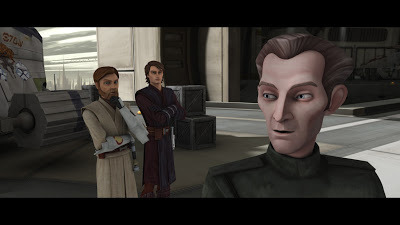 Captain Tarkin is on the rightFor those of you who are fans of the original Star Wars movies, you may remember Grand Moff Tarkin having this little exchange with Princess Leia:
Captain Tarkin is on the rightFor those of you who are fans of the original Star Wars movies, you may remember Grand Moff Tarkin having this little exchange with Princess Leia:"The more you tigthen your grip, Tarkin, the more star systems will slip through your fingers."We get to know Tarkin a lot better in the cartoon series The Clone Wars. One of the episodes I'm thinking of is "Citadel" and it's subsequent sequels that take place near the tail end of the third season. In that episode, Captain Tarkin and Jedi General Even Piell undertook a mission to find the Nexus Route, a strategically valuable hyperspace route which would lead into both the heart of the Galactic Republic and the Confederacy of Independent Systems (that's where all the Separatist planets are). During the mission, they were ambushed and attacked by Separatist forces. Before they got boarded, Piell and Tarkin each memorized half of the information regarding the Nexus Route before erasing it from the ship's computer files. After being forced to surrender, Tarkin and Piell, along with other officers were taken as prisoners to the Citadel, a Separatist prison on Lola Sayu.
--Leia Organa to Grand Moff Tarkin
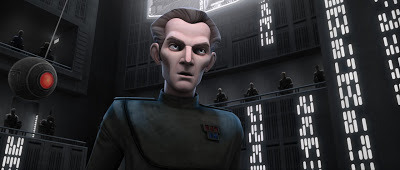 Captain Tarkin at the end of season five sentencing Ahsoka Tano for
Captain Tarkin at the end of season five sentencing Ahsoka Tano forbombing the Jedi Temple. His manner, appearance, and uniform strike
me as being very "Nazi" ish, which I'm sure is intended.
 Needless to say, Obi-Wan Kenobi, Anakin Skywalker, and padawan Ahsoka Tano rescue Tarkin from the Citadel. However, not before Tarkin let's loose with this little bit of conversation to Anakin:
Needless to say, Obi-Wan Kenobi, Anakin Skywalker, and padawan Ahsoka Tano rescue Tarkin from the Citadel. However, not before Tarkin let's loose with this little bit of conversation to Anakin:Anakin: "You lack faith in the Jedi."Basically, what Tarkin says reminds me of what I think a dictator would say. You know...the kind like Assad of Syria that would feel it's okay to turn chemical weapons on his own people. Also, with regard to the above quote, Anakin agrees with Tarkin in that episode. All the signs were there. Obi-Wan should not have been surprised that Anakin went to the Dark Side so easily. In this YouTube clip Anakin and Tarkin exchange words, basically trying to outdo each other on how well they know Chancellor Palpatine (he later becomes the Emperor).
Tarkin: "I find their tactics ineffective. The Jedi Code prevents them from going far enough to achieve victory, to do whatever it takes to win, the very reason why peacekeepers should not be leading a war."
I'm pretty sure that at the time of Star Wars: A New Hope arrived, Tarkin was the most powerful non-Force user in the Empire. I think he even outranked Vader, but don't quote me on that. It just sure seemed like it.
Published on April 23, 2013 05:59
April 21, 2013
Savage Opress gave me six insights as to why Star Wars is really a story about revenge
 Three villains from the Clone Wars television series. From left to right:
Three villains from the Clone Wars television series. From left to right:Darth Maul (yes he lived), Savage Opress, and Pre Vizsla (leader of Death
Watch). They are all motivated by revenge. Pre Vizsla wanted revenge on
those factions on Mandalore who had turned the populace away from
their historical warrior-like way of life. In the U.S., he'd be a member of the N.R.A.A little background first so you aren't sitting there scratching your head in confusion.
Savage Opress was a Dathomirian Zabrak Nightbrother who became a Sith Lord alongside his brother, Darth Maul, during the Clone Wars television series. He came about in the third season because Darth Sidious (Emperor Palpatine) demanded that Count Dooku kill his most prized apprentice, Asajj Ventress. Asajj had become too powerful and as a result, created a "disturbance" in the force. In a nutshell, Darth Sidious did not want his own apprentice (Count Dooku) to rise up and overthrow him (which is entirely possible if he trained an apprentice with as much power as Dooku wielded). It's also great foreshadowing to the fact that Sidious is overthrown by his own apprentice (Darth Vader) in "Return of the Jedi." I love that scene because it's a testament of how powerful Darth Vader really was. He single-handedly did it all himself and relied on no help at all. Just kind of a "You know what old man? I'm really tired of your crap, and I've decided this is your retirement party." And it was done. Something Yoda, Mace Windu, and probably countless others could never accomplish.
It must be difficult being a powerful Sith Lord. Not only do you have to worry about the Jedi, but you must always look to your own for possible backstabbing. It kind of makes the whole "this is a team effort" motif problematic, because your team could turn on you at any time.

Anyway, the reason for my post today is (up until I got introduced to Savage Opress) I kind of thought the Star Wars universe was this big space opera that could inspire all kinds of fan fiction, and that it's so huge that you could literally tell any story. I suppose that at least part of that is true. However, I also think that if you wanted to stay with Lucas' vision for whatever reason (since Star Wars is his baby), I believe you'd want to stick with the whole "revenge" theme in any plot or story you wrote. Revenge literally infuses practically every story line and drives all the evil you see present in Star Wars from the movies to the television series and probably even the comic books and novels. Here's my "rudimentary" evidence:
1) Lucas called the third prequel "Revenge of the Sith." That's pretty straight-forward. Obviously the Sith are very butt hurt at being oppressed by the Jedi and really really want their revenge. And it matters so much that the very word makes it into a title.
2) In the television series, Savage Opress is birthed out of revenge when Asajj Ventress survives and wants revenge against her former master that tried to kill her. So the Nightsister witches make Savage Opress out of black magic and then plan on using him as an assassin that they can control once he learns enough from being Count Dooku's apprentice.
3) The whole "dark side" seems to be motivated out of revenge. In other words, the Sith often seem to channel hate for some wrong that they feel they've been dealt and want revenge against the people who wronged them.
4) Darth Maul is cleverly re-written as someone who survives being cut in half and naturally, he wants revenge on the person that cut him in half, i.e., Obi-Wan Kenobi. So he gets his revenge by killing Duchess Satine right in front of him about mid-way through Season 5, because Obi-Wan loves Duchess Satine. Nice revenge plot there.
5) Anakin starts to slip to the dark side when he kills a whole clan of Tuskan Raiders after they kill his mother. If that isn't revenge, I don't know what is.
6) Bounty Hunter Boba Fett is totally motivated out of revenge after witnessing the Jedi cut down his father Jango Fett in the second movie. They even show the boy touching his head to his father's helmet.
So there you have it. Savage Opress gave me six insights as to why Star Wars is really a story about revenge. So I predict episode VII will probably kick off three more movies centered around revenge. Someone will be extremely butt hurt over something and then they will spend three movies trying to deal with that "wronged" person. I actually hope it's not formulaic like that, but let's be honest...a lot of Star Wars is formulaic. A lot of publishing for that matter. We are creatures of habit and we love our formulas!
Don't even get me started on James Bond.
Published on April 21, 2013 23:05
April 19, 2013
The Rise of Evil in season three of the Clone Wars sets the tone of things to come
We all know that the Star Wars prequels end badly for the good guys. But even if you didn't and watched the Clone Wars cartoon series, you would probably get that impression alone from season 3. Not only do we have some very key episodes beginning with "Nightsisters," but we have a three-part storyline that begins with "Overlords," continues in "Altar of Mortis," and ends with "Ghosts of Mortis." So basically, the rise of evil in season three of the Clone Wars sets the tone of things to come. If you like dark fantasy, these episodes are right up your alley.
 This is Mother Talzin. She gives me the creeps, and her voice is equally evil.First off, the episode called "Nightsisters" is downright creepy. Asajj Ventress betrayed by Count Dooku is set adrift in deep space and rescued by a freighter that finds her damaged vessel just floating through space. Once they wake her up, she kills them all and takes their ship to a planet that is best described as dripping blood and black magic. It's also home to a race of women called the Nightsisters and a race of men who gave birth to the legendary Sith Lord, Darth Maul. Just picturing those two getting together to produce children brings up images I really don't want to imagine.
This is Mother Talzin. She gives me the creeps, and her voice is equally evil.First off, the episode called "Nightsisters" is downright creepy. Asajj Ventress betrayed by Count Dooku is set adrift in deep space and rescued by a freighter that finds her damaged vessel just floating through space. Once they wake her up, she kills them all and takes their ship to a planet that is best described as dripping blood and black magic. It's also home to a race of women called the Nightsisters and a race of men who gave birth to the legendary Sith Lord, Darth Maul. Just picturing those two getting together to produce children brings up images I really don't want to imagine.
The Nightsisters are an entirely female group of individuals...witches...led by a woman called Mother Talzin that you seriously would not want to meet in a dark alley. She's scary, is basically an evil wizard, and has trained all of the women of her clan to be assassins and witches.
 This is the Son of Mortis wielding the Dagger of Mortis. One things for sure...there's no disputing
This is the Son of Mortis wielding the Dagger of Mortis. One things for sure...there's no disputing
that he's evil. Just look at his wardrobe."Overlords", "Altar of Mortis", and "Ghosts of Mortis" follow the "Nightsisters" storyline. Obi-Wan, Anakin, and Ahsoka become stranded on a mysterious planet where the Force is incredibly strong. Three powerful entities called the Father, Son, and Daughter live there. And when I say powerful, I mean these entities wield the force like gods. The Father can grab the end of a lightsaber with his bare hand and thrust it away. The Son turns off lightsabers with a gesture of his hand and can shapechange into a flying demon. And the daughter has similar powers and glows in the dark (a very interesting effect). The Father tells Anakin that the Sith hunger for their power, and that it's a constant struggle to keep his two children (representing Light and Darkness) in balance with each other.
Anyway, the Son ends up taking Ahsoka captive in an attempt to entice Anakin into joining him to use their combined strength to overpower his Father and Sister. To this end, the Son casts Ahsoka under the spell of the dark side. To turn Anakin to the Dark Side, the Son shows Anakin future images of himself causing so much pain and death as the Sith Lord Darth Vader...and despite what you want to think, it actually ends up working because Anakin joins the Son to keep himself from that fate. Very logical, right? Anyway here are some clips for you from these episodes. Enjoy!
And below is the clip showing Mother Talzin dispatching assassins to kill Count Dooku. It's a great clip. You should watch it mmhmm.
 This is Mother Talzin. She gives me the creeps, and her voice is equally evil.First off, the episode called "Nightsisters" is downright creepy. Asajj Ventress betrayed by Count Dooku is set adrift in deep space and rescued by a freighter that finds her damaged vessel just floating through space. Once they wake her up, she kills them all and takes their ship to a planet that is best described as dripping blood and black magic. It's also home to a race of women called the Nightsisters and a race of men who gave birth to the legendary Sith Lord, Darth Maul. Just picturing those two getting together to produce children brings up images I really don't want to imagine.
This is Mother Talzin. She gives me the creeps, and her voice is equally evil.First off, the episode called "Nightsisters" is downright creepy. Asajj Ventress betrayed by Count Dooku is set adrift in deep space and rescued by a freighter that finds her damaged vessel just floating through space. Once they wake her up, she kills them all and takes their ship to a planet that is best described as dripping blood and black magic. It's also home to a race of women called the Nightsisters and a race of men who gave birth to the legendary Sith Lord, Darth Maul. Just picturing those two getting together to produce children brings up images I really don't want to imagine.The Nightsisters are an entirely female group of individuals...witches...led by a woman called Mother Talzin that you seriously would not want to meet in a dark alley. She's scary, is basically an evil wizard, and has trained all of the women of her clan to be assassins and witches.
 This is the Son of Mortis wielding the Dagger of Mortis. One things for sure...there's no disputing
This is the Son of Mortis wielding the Dagger of Mortis. One things for sure...there's no disputingthat he's evil. Just look at his wardrobe."Overlords", "Altar of Mortis", and "Ghosts of Mortis" follow the "Nightsisters" storyline. Obi-Wan, Anakin, and Ahsoka become stranded on a mysterious planet where the Force is incredibly strong. Three powerful entities called the Father, Son, and Daughter live there. And when I say powerful, I mean these entities wield the force like gods. The Father can grab the end of a lightsaber with his bare hand and thrust it away. The Son turns off lightsabers with a gesture of his hand and can shapechange into a flying demon. And the daughter has similar powers and glows in the dark (a very interesting effect). The Father tells Anakin that the Sith hunger for their power, and that it's a constant struggle to keep his two children (representing Light and Darkness) in balance with each other.
Anyway, the Son ends up taking Ahsoka captive in an attempt to entice Anakin into joining him to use their combined strength to overpower his Father and Sister. To this end, the Son casts Ahsoka under the spell of the dark side. To turn Anakin to the Dark Side, the Son shows Anakin future images of himself causing so much pain and death as the Sith Lord Darth Vader...and despite what you want to think, it actually ends up working because Anakin joins the Son to keep himself from that fate. Very logical, right? Anyway here are some clips for you from these episodes. Enjoy!
And below is the clip showing Mother Talzin dispatching assassins to kill Count Dooku. It's a great clip. You should watch it mmhmm.
Published on April 19, 2013 23:04
April 18, 2013
Queen Miraj Scintel
 Queen Miraj Scintel was a villain in Star Wars: The Clone Wars television series' fourth season. She appears in episode twelve called "Slaves of the Republic."
Queen Miraj Scintel was a villain in Star Wars: The Clone Wars television series' fourth season. She appears in episode twelve called "Slaves of the Republic."The theme of slavery is nothing new to the Star Wars canon. Anakin was a slave at one time, and his mother remained a slave for the majority of her life. In "Slaves of the Republic" Anakin, Obi-Wan, and Ahsoka go undercover to infiltrate the slavers on the planet Zygerria in order to find colonists (members of Ahsoka's people) who have been kidnapped from Kiros and forced into slavery. In the slave markets near the palace, Ahsoka draws unwelcome attention when she prevents a slaver from whipping one of his slaves. Anakin slyly gets them out of the mess and gets an invite to the palace by order of the queen herself.
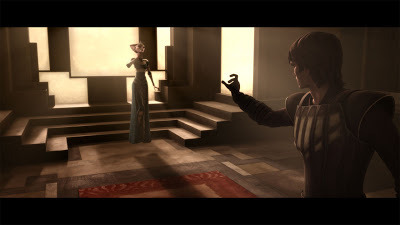 Anakin force-choking the queen. I guess she was a villain, so this kind
Anakin force-choking the queen. I guess she was a villain, so this kindof behavior is acceptable, right? Or is it foreshadowing to come?Posing as a slaver, Anakin is quick to win the queen's favor. He claims he killed a guy named Bruno Denturri and seized Ahsoka from his abode. He also flirts with the Queen. While Anakin is conversing thus, one of the Queen's slaves attempts to stab her and Anakin intervenes. As a result, the slave throws herself to her death. The queen needing a replacement, takes Ahsoka as her new slave. Having won her heart, the queen invites Anakin to the slave auction that night (you get the impression that this is kind of a first date thing).
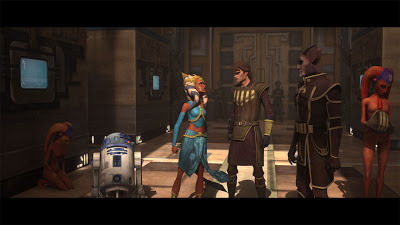 I love the ancient Egyptian feel of this episode. While Anakin is keeping the queen busy, Obi-Wan rescues the captured governor of Kiros from the slave pits. But the governor doesn't know where all of his people are. Helping the governor to escape, Obi-Wan is captured and of course, tortured. All slave masters torture you know? And Obi-Wan being a famous Jedi does not go unnoticed by the queen.
I love the ancient Egyptian feel of this episode. While Anakin is keeping the queen busy, Obi-Wan rescues the captured governor of Kiros from the slave pits. But the governor doesn't know where all of his people are. Helping the governor to escape, Obi-Wan is captured and of course, tortured. All slave masters torture you know? And Obi-Wan being a famous Jedi does not go unnoticed by the queen.
So you can see where this is going. At the auction that night, the Queen announces a special entertainment and invites Anakin to whip Obi-Wan. Anyway, Obi-Wan, Anakin, and Ahsoka are soon exposed for what they are (the queen is no fool!) and she forces Anakin to be her sex slave saying that she'll hurt his friends if he doesn't pleasure her.
And the same emotional blackmail is used against Obi-Wan and Ahsoka by holding hostage innocent people who will be tortured and killed if they rebel against her.
Anyway, this episode is a great example of where you start to see Anakin's moral compass fray around the edges. It's really quite terrible that Jedi who experience intense emotions and act upon them are basically embracing the dark side. It seems only human to want to protect your own from being hurt. Yet to do just that is oftentimes what separates the Sith from the Jedi.
Have a great Friday :)
Published on April 18, 2013 23:18
April 17, 2013
Padawan Ahsoka Tano exemplifies the best of the Jedi even if she doesn't have the title
 The very last scene of the Clone Wars. It ended with Ahsoka Tano leaving
The very last scene of the Clone Wars. It ended with Ahsoka Tano leavingthe Jedi Order. Anakin begged for her to return. But she refused. And
that is how one of the greatest Jedi stories ended.
 "Snips," Anakin whispered from the wreckage of the A-Wing.
"Snips," Anakin whispered from the wreckage of the A-Wing.Ahsoka clenched her teeth as she heard the familiar nickname.
Internally, she counted the seconds while she mustered enough courage to reply. With a sigh, she stood with palms flat on the fuselage and lifted herself up slowly...painfully.
A small smile crept across her lips; hood masked her face. “Always in time to save your life Sky Guy,” she answered him. She felt a particular joy that only Anakin could summon. Always her Master, Anakin believed in her no matter what, and she'd come to rely upon his resolve in frightening times.
Waiting for his reply, Ahsoka became satisfied in the silence that hung between them both.
It wasn't the silence that you associate with awkwardness. It was the silence of mutual friends basking in each others presence.
 This gif is from an episode where Ahsoka fights Death Watch. It's a really
This gif is from an episode where Ahsoka fights Death Watch. It's a reallycool episode. R2 hands her the lightsabers, she cuts herself free, and jumps
coming down and killing like four Death Watch in Mandalorian armor at the
same time. She just cuts their heads off (yes beheadings in a cartoon for kids).From Wikipedia --
George Lucas stated that the character of Ahsoka was developed for the series as a means of illustrating how Anakin Skywalker develops from the brash, undisciplined Padawan in Star Wars Episode II: Attack of the Clones to the more reserved Jedi Knight in Star Wars Episode III: Revenge of the Sith. However, Master Yoda worries about Skywalker's personal relationships. By giving Skywalker his own Padawan, it would place the character into a paternal role where he would be forced to become more cautious and responsible. It would also give Skywalker new insight into his relationship with his own mentor, Obi-Wan Kenobi, and explain how their relationship matured. Lucas stated that, having raised two daughters, he "knew something about the subject," and decided to make Skywalker's apprentice a young female.
My take -- Ahsoka Tano is my favorite character in the series. She just really grew on me season after season. The Star Wars movies had a vacuum of female Jedis. Previously, I'd been intrigued by Luminara Undulee and her Padawan Barriss Offee, but these characters never got any screen time in the movies (you see them once in the Battle of Geonosis). Ahsoka, however, is a star in The Clone Wars. She's powerful, incredibly skilled, and a person that (unlike Anakin) could never go to the dark side. Her moral compass is without question as straight as the one possessed by dead Jedi Master Qui-Gon Jinn.
The Clone Wars ended with Ahsoka leaving the Jedi council forever because when it came down to it, the Jedi council, did not trust her (even Mace Windu and Yoda thought she might be guilty). The only one that did believe her was Anakin, and he proved this by bringing the traitor Barriss Offee to justice (Barriss had framed Ahsoka for a terrorist bombing of the Jedi Temple) even though it meant allying with a known dark side apprentice named Asajj Ventress to do so.
 Disciple of the Dark Side, Asajj Ventress held the key to Ahsoka's innocence.Maybe it's as early as this event that Anakin began to question and to hate the Jedi Order for alienating him from Ahsoka.
Disciple of the Dark Side, Asajj Ventress held the key to Ahsoka's innocence.Maybe it's as early as this event that Anakin began to question and to hate the Jedi Order for alienating him from Ahsoka.I hope to someday know of the fate of Ahsoka Tano. Did she survive when all the Jedi were eradicated throughout the galaxy? She had all of the skills to be a full blown Jedi Knight, but she didn't have the title. Perhaps Anakin as Darth Vader never looked for her. All I know is that when Yoda died in Return of the Jedi, he said to Luke, "When gone am I, the last of the Jedi will you be." I suppose technically that means Ahsoka could still be alive.
In the end, Padawan Ahsoka Tano exemplifies the best of the Jedi even if she doesn't have the title.
Below is a video that shows many highlights from Season 3. It will give you a feel of who Ahsoka Tano was and how the most powerful of the Jedi (Anakin) also had the most interesting padawan. They don't show it in this clip, but when Ahsoka has embraced the dark side and fights Anakin (foreshadowing anyone?) he pushes her with telekinesis and she stops herself by thrusting two lightsabers into the ground and leaving a trail of molten lava behind. I thought that was really cool.
And below is a clip that shows Ahsoka Tano battling General Grievous. For those of you who don't know, General Grievous killed Jedi during the Clone Wars and was trained by Count Dooku himself in lightsaber combat. He's a droid that even some Jedi Masters had trouble dealing with (like Kit Fisto). Ahsoka fights
 him because he wants to kill younglings (those Jedi babies who are still too weak with the force to defend themselves against a truly skilled opponent). Ahsoka (because she's Anakin's padawan) is no mere student. She's very much like Obi-Wan, able to take on much more powerful foes (remember Obi-Wan fought Darth Maul while he was still a padawan of Qui-Gon Jinn).
him because he wants to kill younglings (those Jedi babies who are still too weak with the force to defend themselves against a truly skilled opponent). Ahsoka (because she's Anakin's padawan) is no mere student. She's very much like Obi-Wan, able to take on much more powerful foes (remember Obi-Wan fought Darth Maul while he was still a padawan of Qui-Gon Jinn).It was a difficult choice to pick clips to show you guys. When I get to "V" in this whole A to Z challenge I'm going to talk about Asajj Ventress and show you the clip where Ahsoka fights Asajj (but it's really Barriss Offee in disguise). Barriss goes to the dark side by the end of the series and she's INCREDIBLY powerful. Her telekinetic powers are way better than Vader and in the clip I intend to show you in a week or so, you'll see that.
If you are a Star Wars fan and have never heard of the Clone Wars, I urge you to take the time to watch these videos. They are AWESOME.
Published on April 17, 2013 23:01
April 16, 2013
Obi-Wan Kenobi would have left the Jedi Order for Duchess Satine
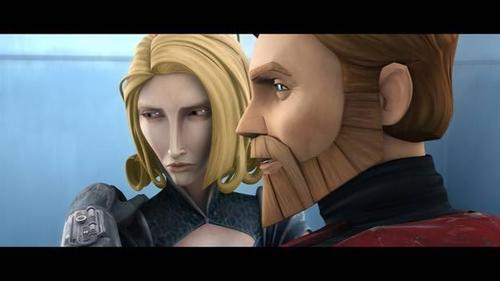
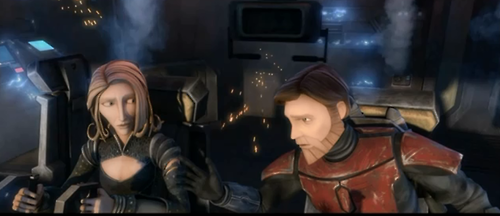
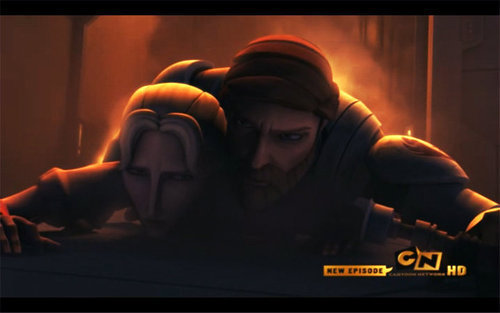
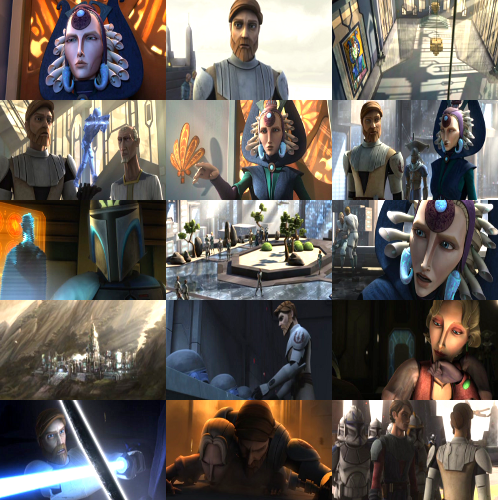 A collage of many scenes involving Duchess Satine and Obi-Wan.Obi-Wan Kenobi said to Duchess Satine before she died, "Had you said the word, I would have left the Jedi Order." After he said that, it was hard not to burst into tears. Oy...what a heart wrenching scene.
A collage of many scenes involving Duchess Satine and Obi-Wan.Obi-Wan Kenobi said to Duchess Satine before she died, "Had you said the word, I would have left the Jedi Order." After he said that, it was hard not to burst into tears. Oy...what a heart wrenching scene.After Satine's death, he was asked, "Did you love Satine?"
Obi-Wan replied, "As a Jedi, I'm not to form emotional attachments. But, yes. I did."
 In a way, I'm glad that they canceled The Clone Wars cartoon series. The death of Duchess Satine really put a cap on it. She was Obi-Wan's greatest and probably only love in his life, and arguably one of the most influential figures in the canon (mostly because I think Obi-Wan Kenobi was the greatest hero of the Old Republic).In the clip below, I've embedded the only scene in which I can recall where Obi-Wan Kenobi fights with a red lightsaber. He does joke to Asajj Ventress that "It's not my color." Setup: Darth Maul and his apprentice Savage Oppress are about to kill Obi-Wan when Asajj Ventress (a Sith who is a recurring character and not entirely bad) comes to the rescue. I really got to where I liked Ventress. Sure, she hated the Jedi but she had her reasons. She always fought with two lightsabers and because Obi-Wan doesn't have one (and they're about to be attacked) he borrows one of hers. It's an awesome fight scene.
In a way, I'm glad that they canceled The Clone Wars cartoon series. The death of Duchess Satine really put a cap on it. She was Obi-Wan's greatest and probably only love in his life, and arguably one of the most influential figures in the canon (mostly because I think Obi-Wan Kenobi was the greatest hero of the Old Republic).In the clip below, I've embedded the only scene in which I can recall where Obi-Wan Kenobi fights with a red lightsaber. He does joke to Asajj Ventress that "It's not my color." Setup: Darth Maul and his apprentice Savage Oppress are about to kill Obi-Wan when Asajj Ventress (a Sith who is a recurring character and not entirely bad) comes to the rescue. I really got to where I liked Ventress. Sure, she hated the Jedi but she had her reasons. She always fought with two lightsabers and because Obi-Wan doesn't have one (and they're about to be attacked) he borrows one of hers. It's an awesome fight scene.And yeah for those of you who don't know, Darth Maul didn't die in episode 1: The Phantom Menace. He just got cut in half, abandoned by Palpatine, and pieced together with artificial legs.
Published on April 16, 2013 23:19
April 15, 2013
Nute Gunray is every bit a racist Asian stereotype
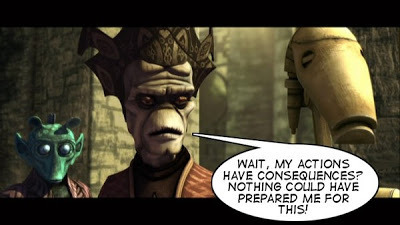 Nute Gunray"The Phantom Menace" gave us many offensive characters. Jar Jar Binks was a racist stereotype that poked fun at African American people. His mannerisms and speech seemed to be modeled on stereotypical and racist views of Blacks. And in the same movie, Lucas managed to also single out Jewish people with Watto the junk dealer who concerned himself with "only money." But still not satisfied with that, Lucas gave us Nute Gunray, thereby sealing "The Phantom Menace" as having a trifecta of some of the most racially offensive characters in history. And you're in luck, because Nute Gunray is in the Clone Wars cartoon series and that's who I'm going to talk about today :).
Nute Gunray"The Phantom Menace" gave us many offensive characters. Jar Jar Binks was a racist stereotype that poked fun at African American people. His mannerisms and speech seemed to be modeled on stereotypical and racist views of Blacks. And in the same movie, Lucas managed to also single out Jewish people with Watto the junk dealer who concerned himself with "only money." But still not satisfied with that, Lucas gave us Nute Gunray, thereby sealing "The Phantom Menace" as having a trifecta of some of the most racially offensive characters in history. And you're in luck, because Nute Gunray is in the Clone Wars cartoon series and that's who I'm going to talk about today :).Nute Gunray was a Neimodian who served as a Minister of the Trade Federation. His first real episode is "Bombad Jedi," which is the eighth episode of season one of the television series Star Wars: The Clone Wars.
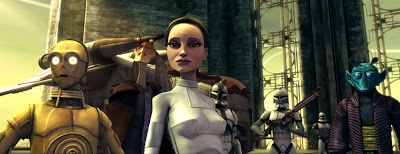 Threepio, Jar-Jar as a Jedi and Padme Amidala on Rodia.In this episode, Amidala is sent by Chancellor Palpatine on secret mission to Rodia (remember Greedo?) to negotiate a peace treaty. On her way, she meets up with a Rodian friend who just happens to be a traitor working for Nute Gunray (the head of the evil Trade Federation that was responsible for keeping a stranglehold on Amidala's home planet of Naboo). Anyway, this traitor captures Amidala and Jar Jar Binks disguises himself as a Jedi and tries to rescue her. With a little help from a sea monster and her friend (who has second thoughts on allying with Gunray), Padme is rescued and Nute Gunray is captured. The episode is named "Bombad Jedi" because Padme's friend calls Jar Jar "Master Bombad."
Threepio, Jar-Jar as a Jedi and Padme Amidala on Rodia.In this episode, Amidala is sent by Chancellor Palpatine on secret mission to Rodia (remember Greedo?) to negotiate a peace treaty. On her way, she meets up with a Rodian friend who just happens to be a traitor working for Nute Gunray (the head of the evil Trade Federation that was responsible for keeping a stranglehold on Amidala's home planet of Naboo). Anyway, this traitor captures Amidala and Jar Jar Binks disguises himself as a Jedi and tries to rescue her. With a little help from a sea monster and her friend (who has second thoughts on allying with Gunray), Padme is rescued and Nute Gunray is captured. The episode is named "Bombad Jedi" because Padme's friend calls Jar Jar "Master Bombad."Below is a clip from the episode featuring everyone's favorite character, Jar-Jar Binks. Honestly...I hated this episode. And that's probably why it stuck in my memory.
Why do I think Nute Gunray is a racist stereotype?
1) He speaks with an Asian accent.
2) He works in the tech field (the Trade Federation is full of droid workers, robots, etc.)
3) He is every bit an unfortunate racial stereotype of Japanese businessmen, treating "trade" like "war."
 4) Emasculation and asexuality. From Wikipedia: Chinese laborers in the mid 1800s were given an emasculated image due to physical appearance and the fact they did what Americans considered to be "women's work." They wore long silk gowns (which Gunray does) and usually had long braids.
4) Emasculation and asexuality. From Wikipedia: Chinese laborers in the mid 1800s were given an emasculated image due to physical appearance and the fact they did what Americans considered to be "women's work." They wore long silk gowns (which Gunray does) and usually had long braids.So yeah...there you have it. Racism is alive and well in children's cartoons people! But I still like the series as a whole. I guess nothing is perfect. If I could ask Lucas one question though, it would be "what the hell were you thinking when you made this character?"
Published on April 15, 2013 23:02
The Mandalore Plot
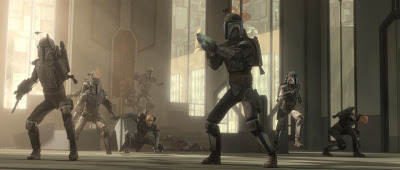 The soldiers of "Death Watch." They are dressed in Mandalorian armor,
The soldiers of "Death Watch." They are dressed in Mandalorian armor,which should remind you of Boba Fett. Click to embiggen. Yes, this is
an actual screenshot from the Clone Wars and not a painting. The
animation is really THAT good. NOTE: this is not from the episode I'm
talking about. It's just a really cool screen grab. Dude on the throne is
Darth Maul (this is from season 5) Guy without a helmet in front of Maul
is the Governor of Concordia (moon of Mandalore)."The Mandalore Plot" is the twelfth episode in Season Two of the Star Wars: The Clone Wars television series, and I think, stands out as a pinnacle of good storytelling. Here's why in a nutshell:
1) Mandalore is a world behaving similar to the nation of Switzerland on Earth. It's neutral. It wants to stay out of the conflict going on between the Separatists (the droid armies and Count Dooku) and the galactic government.
2) Mandalorian armor is the stuff that Boba Fett wears. It's the really cool tight-fitting combat armor that you now see everywhere from G.I. Joe, to first-person shooters, to Iron-Man, to my own books, etc. Just think "athletic young guys wearing sexy battle armor" and you got the picture.
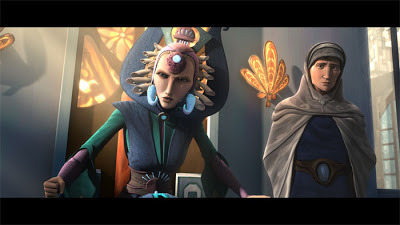 Duchess Satine. The headress she wears smacks of Queen Amidala
Duchess Satine. The headress she wears smacks of Queen Amidalain episode 1: The Phantom Menace. Anyway, I really got to like her (more so
than Amidala). I think it had to do with the fact that her love to Obi-Wan
never seemed forced because let's face it, Lucas had to get Anakin and
Amidala together in like the screen time of two hours flat.3) Mandalore is ruled by a woman by the name of Duchess Satine. Satine is beautiful, smart, bold, and a really charismatic character. And she becomes a staple in the series, appearing in many episodes because Obi-Wan Kenobi ends up falling in love with her. Yes, the Clone Wars cartoon series is the only place we actually see what Obi-Wan's life could have been because it's never revealed in the movies that he loved a woman.
4) "The Mandalore Plot" is a mystery/thriller that unfolds intricately and weaves its way into other storylines that pass from episode to episode. I like that. We also get a recurring villain in the Governor of Concordia (moon of Mandalore).
Here's a summary for you on what happens in the episode:
 Obi-Wan arrives on Mandalore and meets Duchess Satine (of course he thinks she's pretty groovy looking). Satine tells Obi-Wan of a rogue group of Mandalorians called Death Watch who may be responsible for terrorist attacks on a Republic cruiser. They are criminals hiding out on the moon Concordia.
Obi-Wan arrives on Mandalore and meets Duchess Satine (of course he thinks she's pretty groovy looking). Satine tells Obi-Wan of a rogue group of Mandalorians called Death Watch who may be responsible for terrorist attacks on a Republic cruiser. They are criminals hiding out on the moon Concordia.Death Watch launches a terrorist attack on Mandalore and both Obi-Wan and Satine chase down a man responsible who tries to jump to his death rather than be interrogated. A few seconds before he bites it, he whispers some last words to the Duchess in the dialect of Concordia.
Below is the short video clip wherein you see the explosion done by the terrorist group, Death Watch, and a conversation between Obi-Wan and Duchess Satine. Again, the animation is amazing.
So Satine and Obi-Wan pay a visit to Concordia. She goes to dinner with the Governor of the moon wearing a wire in her ear through which she can hear Obi-Wan (women are so duplicitous). Meanwhile he goes to investigate a "non-operational" mine. Obi-Wan gets captured by Death Watch, Satine hears it, and goes off to save him! It turns out that the Governor is the leader of Death Watch and he and Obi-Wan battle lightsaber vs. darksaber in a duel (of course Obi-Wan wins). The Governor escapes though and orders his Death Watch to kill them both. Obi-Wan and Satine escape Concordia to Mandalore safely, and despite the evidence that the Separatists are aiding Death Watch, Satine insists on Mandalore staying neutral.
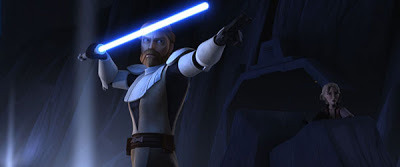 Obi-Wan protecting his babe, Satine, who's hiding up on the rocks behind
Obi-Wan protecting his babe, Satine, who's hiding up on the rocks behindhim. He's facing off against the Governor wielding a darksaber pictured
below.
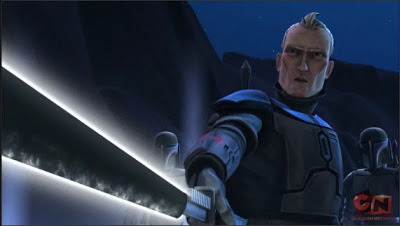 The Governor of Concordia. In his hands is the afore-mentioned darksaber.
The Governor of Concordia. In his hands is the afore-mentioned darksaber.I've no idea how it's different than a lightsaber. Maybe Andrew will stop
by and let us all know in a comment. I do kind of dig the Gov's mohawk.
Published on April 15, 2013 01:26
April 12, 2013
Luminara Unduli versus the droid saboteurs of Ilum
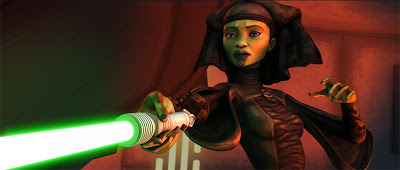 Today I want to tell you about one of my favorite secondary characters in the Cartoon Network's The Clone Wars. Her name is Luminara Unduli. She was a Jedi Master and trained Barriss Offee (you can find the post that I did on Barriss located
HERE
).
Today I want to tell you about one of my favorite secondary characters in the Cartoon Network's The Clone Wars. Her name is Luminara Unduli. She was a Jedi Master and trained Barriss Offee (you can find the post that I did on Barriss located
HERE
). First off, Luminara was a complete master of Soresu style combat. In Soresu, a Jedi uses the lightsaber to establish defense. And even if an attack manages to get past a lightsaber's blade, a proper user of Soresu should be able to avoid the blow through bodily contortions. Essentially, Luminara was almost impossible to hit if she was in her fighting stance. Think of a martial art based on the principle of economy of motion. In other words, keeping up constant blade movement to build up momentum, but at the same time conserve energy. Practitioners of Soresu were marathon fighters, using their lightsaber skills to wear down and tire an opponent and take advantage of them when they made mistakes.
First off, Luminara was a complete master of Soresu style combat. In Soresu, a Jedi uses the lightsaber to establish defense. And even if an attack manages to get past a lightsaber's blade, a proper user of Soresu should be able to avoid the blow through bodily contortions. Essentially, Luminara was almost impossible to hit if she was in her fighting stance. Think of a martial art based on the principle of economy of motion. In other words, keeping up constant blade movement to build up momentum, but at the same time conserve energy. Practitioners of Soresu were marathon fighters, using their lightsaber skills to wear down and tire an opponent and take advantage of them when they made mistakes.Luminara served as a Senior Jedi General in the fading years of the Galactic Republic. She also advised the Jedi High Council, the Supreme Chancellor, and the Galactic Senate.
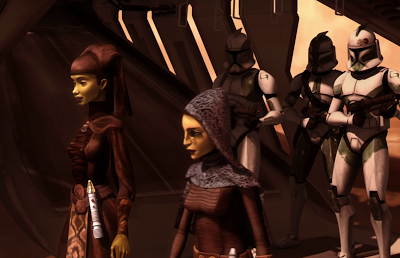 Luminara Unduli (left) and Barriss Offee (right). Luminara loved Barriss, but
Luminara Unduli (left) and Barriss Offee (right). Luminara loved Barriss, butonly in a professional way. She was often critical of Anakin who seemed to
cross a line when it came to his own padawan, Ahsoka Tano. Anakin was
always kind of cursed when it came to women, getting too attached, etc.
And we know how that story went. Luminara was always prepared to lose
her padawan, whereas Anakin would have been devastated.Four months after the Battle of Geonosis depicted in Attack of the Clones, Luminara led Offee to the secret Jedi Temple on the icy world Ilum. This is where the Jedi go to construct their final lightsaber (a right of passage so to speak). During the construction ceremony, Master and Padawan were attacked by cloaked Separatist chameleon droids, which had infiltrated the temple in an attempt to destroy the cavern's precious natural lightsaber crystals. In the destruction of the temple, Barriss and Luminara held up the roof for days with nothing but telekinesis. It's actually a pretty incredibly display of TK and goes beyond anything any of the other Jedi ever did with the same power. I think Barriss and Luminara together had the strongest telekinetic ability out of any of their contemporaries.
Below is the clip of Luminara Unduli versus the droid saboteurs of Ilum. The animation comes from the 2003 Clone Wars series which predates the one with the fantastic animation that I've been raving about for weeks now. If you are a Star Wars fan, you should watch it, because it is the only clip I know of that shows exactly how a lightsaber is assembled and what goes inside it.
Published on April 12, 2013 23:04



